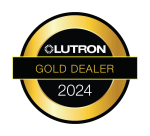Important Things to Consider in a Conference Room Design
When considering a projector in a conference room design, there are many things to consider. Here in this article, we try to narrow it down to the top few items you should consider.
Ideal Screen Size
Ceiling height, wall width and distance of furthest seat are the three most important dimensions in determining the ideal screen size for your room. Regardless of the size screen you might want, you are going to be limited by these measurements. For example, if you have an 8 foot ceiling and you are mounting the screen in the ceiling, you have a maximum clearance of 8' for screen height. The height of a typical conference table is 30". So using this 8' wall and 30" table, as an example, you would have a maximum screen height size of 8' (or 96") less the 30" of the table, thus leaving you with 66" to work with. We prefer to use a bottom screen height of 36"-40" in order to provide additional clearance above the conference room table. In this example that gives you a maximum usable screen height of 56"-60". To carry this example further, if you are using a 16:10 format wide-screen, with a screen height of 56", then your width would be 89.6". In some cases you may have plenty of height but only so much room on the width of a wall. In that case just reverse this process, starting with the width.
Distance of furthest seat is where a lot of people make an important mistake. Conference rooms are built so that "multiple" people can participate in a discussion while viewing the "same" material. If a person at the end of a table or in a back row can't see, or read what is on the screen then the purpose of the room has been compromised. Many clients think that they can substitute a flat panel for a projector. In a small room you often can. However there is no way you are going to see small numbers on an Excel spreadsheet, even on a 60" flat panel at over 10 feet away. It's unfortunate but many clients don’t follow our advice and end up learning this lesson the hard way. As in any profession, you want to make sure that you use the right tool for right the job. In many cases a flat panel will work well in a small room. It just doesn't work well in a large room or with a long conference table.
One of our screen manufacturers Draper Inc., has this to say about screen height. "Screen height should beat least1/4 the distance from the screen to the furthest seat for charts and data in a conference room". For an example,that means this NEC 55" TV is too small at 12' away and this 65" is only just slightly over the minimum specification.
Screen Format
After you have determined your ballpark screen size you will need to dial it in further based on the screen format you plan to use. Will you use Wide-screen (16:10,16:9) or Standard (4:3)? The 4:3 format isn't much of a factor any longer as almost all new AV Installations are going to use wide-screens. To determine is the best format widescreen size for you, decide what the room will be primarily used for. Will it be for presenting data (spreadsheets, power point, video conferencing) or, for watching motion video? We personally prefer a 16:10 format for business when used to present data from a computer. The 16:10 format allows two document pages to be viewed in Word, full sized and side by side. Recently many of the new laptops have gone to a 16:9 format because it matches the consumer HDTV format for television. Most modern projectors can usually handle either format but we prefer to keep everything with native resolutions when possible. For a business environment we usually spec and prefer 16:10 screens and projectors.
Ambient Light/Lumens
How bright is the room? This is going to be another important consideration. A typical current projector will put out around 3500 ANSI lumens of light. That number is good for a small general use meeting room and depending on how many windows you have, may even allow you to leave some lights on during the presentation. However, for bigger meeting rooms with 12 or more people we would recommend a projector with over 4000 lumens. If you have room in the budget and have a large meeting room you should absolutely be over 4500 and preferably 5000+ lumens. Use caution when comparing specifications on projectors. The specs are not necessarily 100% accurate. Two projectors with the same specs will not necessarily give you the same results. That's where a trusted AV vendor's input can be very helpful. We have often observed this with our own eyes. On paper numbers do not always equate with on the job performance or appearance of two products.
We hope that helps give you a better understanding of what to consider before you upgrade your meeting rooms. There are of course other things to consider but this will get you started and we'll revisit another day for more details. Now you are armed with information on the main things to consider when you are thinking about a purchase for your organization.


